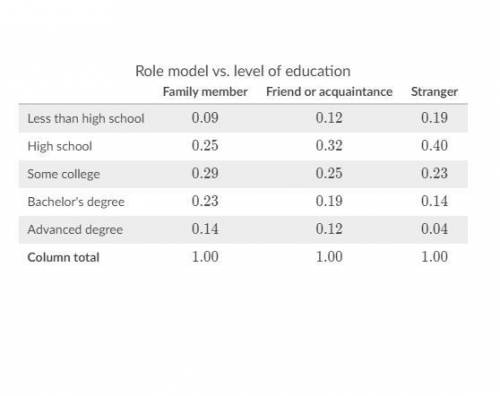
Mathematics, 05.05.2020 20:57 ayoismeisalex
The two-way table of column relative frequencies below summarizes survey data on who a person's role model is and their highest level of education.
Choose 1
(Choice A)
A person whose role model is a family member is less likely to have an advanced degree than a person whose role model is a friend or acquaintance.
(Choice B)
A person whose role model is a stranger is more likely to have high school than some college as their highest level of education.
(Choice C)
A person whose highest level of education is a bachelor's degree is more likely to have a family member than a stranger as a role model.
(Choice D)
A person whose highest level of education is less than high school is more likely to have a stranger than a friend or acquaintance as a role model.


Answers: 2


Other questions on the subject: Mathematics

Mathematics, 21.06.2019 18:30, anishivaturi123
Select the lengths in centimeters that would form a right triangle
Answers: 1

Mathematics, 21.06.2019 21:00, morganpl415
Eliza wants to make $10,000 from her investments. she finds an investment account that earns 4.5% interest. she decides to deposit $2,500 into an account. how much money will be in her account after 14 years?
Answers: 1

Mathematics, 21.06.2019 21:30, camosloppy3150
Aboard 60 in. long is cut two parts so that the longer piece is 5 times the shorter. what are the length of the two pieces?
Answers: 1

Mathematics, 21.06.2019 21:30, gonzalezashley152
In a test for esp (extrasensory perception), the experimenter looks at cards that are hidden from the subject. each card contains either a star, a circle, a wave, a cross or a square.(five shapes) as the experimenter looks at each of 20 cards in turn, the subject names the shape on the card. when the esp study described above discovers a subject whose performance appears to be better than guessing, the study continues at greater length. the experimenter looks at many cards bearing one of five shapes (star, square, circle, wave, and cross) in an order determined by random numbers. the subject cannot see the experimenter as he looks at each card in turn, in order to avoid any possible nonverbal clues. the answers of a subject who does not have esp should be independent observations, each with probability 1/5 of success. we record 1000 attempts. which of the following assumptions must be met in order to solve this problem? it's reasonable to assume normality 0.8(1000), 0.2(1000)%30 approximately normal 0.8(1000), 0.2(1000)% 10 approximately normal srs it is reasonable to assume the total number of cards is over 10,000 it is reasonable to assume the total number of cards is over 1000
Answers: 1
You know the right answer?
The two-way table of column relative frequencies below summarizes survey data on who a person's role...
Questions in other subjects:

Physics, 02.09.2021 08:10

History, 02.09.2021 08:10


Chemistry, 02.09.2021 08:10



Mathematics, 02.09.2021 08:20

Mathematics, 02.09.2021 08:20

Chemistry, 02.09.2021 08:20

Mathematics, 02.09.2021 08:20



